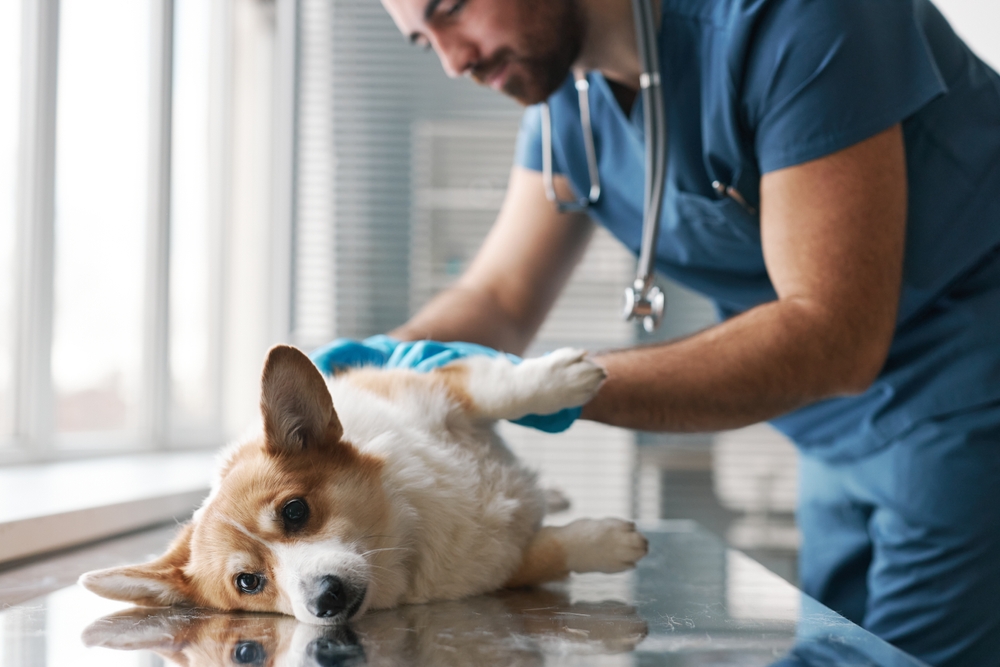The rib cage of a dog serves the function of protecting the internal chest organs, particularly the lungs and heart. That speaks to its importance as the original body armor. It also defines the animal’s form and width. Variations exist between different species and breeds, though. For example, horses have 18 pairs of ribs, pigs can have 14 to 16 pairs, and humans have 12 pairs. But what about dogs?
In dogs, the rib cage consists of the sternum at the floor of the structure with 13 pairs of ribs attached to vertebrae, for a total of 26 ribs. Flexibility is part of its functionality to accommodate the expanding lungs during breathing. There is variation in shape between breeds and this contributes to the canine’s conformation. The rib cage is typically described in part of the official breed standards.


The Shape of the Rib Cage
If you look at a dog straight on, you can see visible differences between various breeds. A Saluki has a narrow chest, which contributes to the animal’s aerodynamic form. On the other end of the spectrum is the barrel chest of the English Bulldog. It’s evident how it influences the dog’s overall shape. For example, the Pembroke Welsh Corgi has an egg-shaped chest, while the German Shepherd Dog is oval-chested.
The ribcage is bounded by the first rib at the front, sternebrae at the bottom, vertebrae at the top and last rib at the back. Within this important structure run vital and delicate parts of anatomy such as the heart and major blood vessels, nerves, respiratory system and part of the digestive tract.


The Anatomy of Canine Ribs
Canine ribs (costae) consist of a head, neck and body. The number of ribs corresponds to the thoracic (chest) vertebrae with which it articulates (joins). The first nine ribs are sometimes called the sternal ribs because they attach to the sternum. The sternum is made up of eight to nine bones collectively called the sternebrae. You may see these ribs referred to as the “true ribs” because of this connection. The next three pairs are some-times called “false ribs,” which are attached to each other with cartilage instead of to the sternum.
The last one is the “floating rib” because it doesn’t articulate with any other structure at the base. The ribs are lightweight yet rigid. Cow, horse, dog, and human bones all have a similar chemical composition with minerals, glycoproteins, and collagen fibrils. That helps to account for the functionality that crosses species lines. Dog ribs are shallow in depth but wide, with a well-defined curve. Arranged in pairs the space between pairs is called the intercostal space.
The entrance to the rib cage at the front is called the thoracic inlet. At the back, the abdomen starts at the last ribs and curves up to form the abdominal tuck that can be seen from a side-on view.
The Ribs as a Diagnostic Tool
The World Small Animal Veterinary Association (WSAVA) developed a tool for veterinarians to use to give an accurate assessment of a pet’s weight called the Body Condition Score. Canine rib anatomy is at its core. The waist of the dog is apparent when looking down at the animal. You can also see the abdominal tuck we discussed previously. A dog with these features is at the ideal weight.
The visible absence of them denotes an overweight pet. Fat covering the abdominal region obscures the rib cage, making the feature difficult to detect. You may also have trouble feeling the ribs. Pet obesity has reached epidemic proportions, and being overweight increases your dog’s risk of diabetes, heart disease, and other chronic conditions. It also worsens the dog’s quality of life.


Final Thoughts
Animals have different numbers of ribs. They are arranged in pairs and function to protect vital internal organs. It’s a product of selective breeding that encourages various body shapes and conformations in dogs. While humans have 12 pairs of ribs, dogs have 13, with 9 true ones, 3 false ones, and a floating rib. Together, they form the rib cage or thorax wall.
Featured Image Credit: Ermolaev Alexander, Shutterstock






